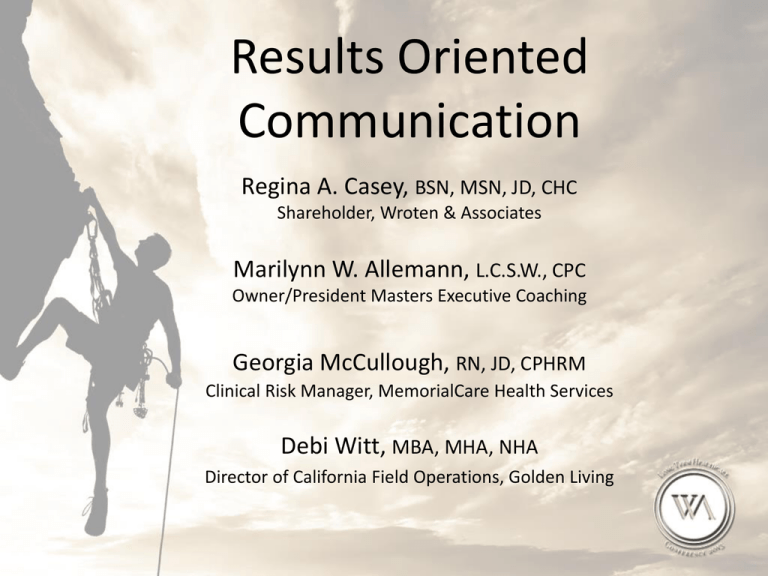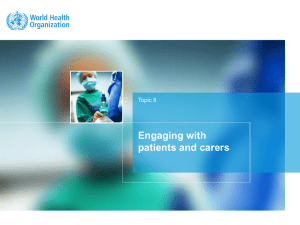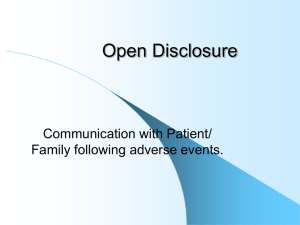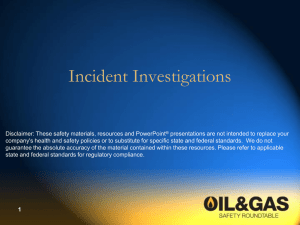Results Oriented Communication
advertisement

Results Oriented Communication Regina A. Casey, BSN, MSN, JD, CHC Shareholder, Wroten & Associates Marilynn W. Allemann, L.C.S.W., CPC Owner/President Masters Executive Coaching Georgia McCullough, RN, JD, CPHRM Clinical Risk Manager, MemorialCare Health Services Debi Witt, MBA, MHA, NHA Director of California Field Operations, Golden Living “The Greatest Problem In Communication Is The Illusion That It Has Been Accomplished.” -- George Bernard Shaw Styles of Communication • Aggressive • Passive • Assertive “When The Eyes Say One Thing, And The Tongue Another, A Practiced Man Relies On The Language Of The First.” -- Ralph Waldo Emerson Methods Of Communication • VERBAL: Speaking, the words we choose and how we say them, tone of voice, intonation and volume. • NON-VERBAL: – Written: Electronic/email/texting. – Body Language: Posture, gestures, facial expressions, eye contact, positioning of arms and legs, and spatial distance. “If We Were Supposed To Talk More Than We Listen, We Would Have Two Mouths And One Ear.” --Mark Twain Listening - A Key To Effective Communication • PASSIVE LISTENING: The basic level of listening. • EVALUATIVE LISTENING: Most of us do this. • INTENTIONAL/ACTIVE LISTENING: The most sophisticated level. Case Study • 86 year old female moves into assisted living facility, Shady Place • Resident is wheelchair bound due to left sided weakness from a stroke and self-propels her wheelchair around facility • Mentally competent and capable of making own healthcare decisions • Resident is a smoker, no documentation of smoking assessment in chart, but considered safe smoker by staff • Spends every afternoon on patio in designated smoking area • Shady Place does not have a written policy or procedure regarding resident smoking nor uses a smoking contract Facts of the Case • Resident living at the facility for one year. • Resident was alone on the patio and catches on fire. • Another resident, who was in his room, smelled smoke, called for help and went to the patio to assist. • Tried to use the hose to put out fire but it did not reach. • As resident was engulfed in flames she cried out “Help me! I am going to die!” • The daughter arrives at the facility and sees Mom being transferred to a gurney to be taken to the hospital, where she dies. Add Video Scenario 1 What was wrong with this scenario? • Stop talking First Listen • Eye contact • Don’t interrupt • If you’re thinking about what you’re going to say, you aren’t listening How to Respond The right way… • "I appreciate your feelings." • "This situation must be very difficult." • " I am so sorry that your are going through this." Not the right way Human Release • Listen – without judgment, – without apologizing, – with compassionate acknowledgment often provides some measure of catharsis and can diffuse frustration and anger. When Unexpected Events Happen • Using the Human Touch to Avoid Litigation Add Video Scenario 2 Investigation • Administrator needs to conduct/oversee an investigation • Interviews with residents, employees, family may be conducted by the Administrator or other assigned person(s) • Root cause analysis • • • • When Do You Investigate Death Missing resident Abuse/neglect allegations Serious accidental injury resulting from a facility practice, action/inaction by staff, or circumstances w/in the facility • Hospitalization resulting from a facility practice, action/inaction by staff, or circumstances w/in the facility • Exploitation allegations Proactive Communication • Meet EMTs at the door and prepare them for anything unusual regarding the patient • Contact ER staff and provide details or history regarding patient (behaviors, wounds, bruising, etc.) • Involve the attending physician Why Investigate? • Statutory duty to investigate, both federal and state • Part of Quality Assurance Process to improve quality of care • Preserve evidence to use in defense if law suit is filed • Federal Law Investigations – Legal obligation to report under 42 CFR § 483.13 (c)(2) – Legal obligation to investigate allegations of neglect or abuse under 42 CFR § 483.13 (c)(3) • State Law – Title 22 CCR § 80061-SNF – Title 22 CCR § 87211-RCFE Investigation • The facility must have evidence that all alleged violations are thoroughly investigated, and must prevent further potential abuse while the investigation is in progress. Investigation • Facility must attempt to identify cause of injury • Document its investigation • Maintain its records in a way that will enable third parties to review what the facility has done or not done to investigate the alleged abuse Facts of the Case The Investigation revealed: • The outside video camera, which allows staff to monitor this area, was broken. • Incident occurred during lunch time, so staff was busy escorting residents to the dining room – no staff member was on patio at the time of the incident. • Several residents interviewed report she frequently would take cat naps on the patio with a lit cigarette. • Staff reported finding holes in the Resident’s clothing and the cushion of her wheelchair, presumably from ash or dropped cigarettes. Scenario 3 Disclosure Policy and Procedure: Step One • Legal: Triage and Assessment – When it’s time to call Legal – Investigation and Analysis of Risk and Value University of Michigan • Disclosure program – Emphasis change from “Deny & Defend” to full disclosure – Utilizes ombudsman mediator • Claims – 262 claims pending in 2001 (new program begins) – 104 claims pending in 2006 – 100 claims pending in 2011 despite expanded practices • Claim closure time reduced by half • Loss rate reduced by third Guarding Your Documents • Incident Reports / Photos / Witness Statements – The relevant inquiry is whether or not the document derives from an investigation into the quality of care or evaluation thereof by medical staff. Santa Rosa Memorial Hospital v. Superior Court (1985) 174 Cal. App. 3d 711, (1985) – "Nothing in section 1157(a) limits the privilege to records that are generated by a medical staff committee, and nothing in the statute supports the suggestion that materials submitted to a committee for review are not protected "records" of the committee.” Alexander v. Superior Court 5 Cal. 4th 1218. (1993) (Overruled on other grounds). Incident Reports / Witness Statements / Photographs Witness should report event to a CQI committee member. Witness should include factual information only in the incident report. As part of ongoing analysis, CQI member should describe the incident and include any other information that might be helpful, including: Evaluation of the witness' actions. Evaluation of responsible party's actions. Analysis of how this incident may be related to other incidents, etc. CQI member’s report should be reviewed and discussed by CQI committee. CQI committee members should be free to add more comments to the incident report, if necessary. Once the entire committee has had an opportunity to review and discuss the incident report and add any comments, each committee member should sign the report. The report should be presented at the next QA Committee Meeting. Disclosure Record • Maintain separate disclosure file as part of Quality Assurance Process • Document – Meetings and discussions – Patient updates to family/patient – Objective – Facts Only! No conjecture, blame, accusations Disclosure • Disclosure – communication of information regarding the results of a diagnostic test or medical treatment. – Factual – Not an Opinion – Not an Apology • Adverse Event – a negative result stemming from a diagnostic test or medical treatment. • Unanticipated Outcome – a result that differs significantly from what was anticipated to be the result of a treatment. Disclosure Policy and Procedure • What should I disclose? – Facts not opinion • When should I disclose? – As soon as possible – Set expectations for more information as investigation proceeds Provide Information • Results of investigation • Not peer review or employee discipline • Establish contact for ongoing communication Disclosure Policy and Procedure: Step Two • Engage Patient/Family and Share Information – Just the facts ma’am! – use Ombudsman as mediator as needed Disclosure Policy and Procedure: Step Three • Mistake and Injury determined – Engage educational opportunities – Engage clinical quality improvement now what? Scenario 4 When & How to Say I’m Sorry Two Categories of Apology • An expression of sympathy or remorse without an admission of fault, mistake or error causing an injury suffered by a patient ("I'm sorry that you are hurt.") and; • An expression of sympathy or remorse with an admission of fault, mistake or error causing an injury suffered by a patient ("I'm sorry that what I did caused your injury.” Historical Perspective I’m Sorry Laws • 1999 Institute of Medicine report: To Err is Human • 2001 JCAHO releases standard re: disclosure • 2001 University of Michigan – “I’m sorry” and transparency becomes policy – A decade of success in reducing litigation State Review of Admissibility • Washington – Statements or benevolent gestures not admissible – Admissions of fault are admissible • Oregon – Any expression of regret/apology not admissible – Admissions of fault may be admissible • California – Statements or benevolent gestures not admissible – Admissions of fault may be admissible • Nevada • Idaho – Statements of sympathy/apology/benevolence/fault – Not admissible • Montana – Statements or benevolent gestures not admissible – Admissions of fault may be admissible Apology in Court • “I would never introduce a doctor's apology in court. It is my job to make a doctor look bad in front of a jury, and telling the jury the doctor apologized and tried to do the right thing kills my case.” President of South Carolina's Trial Lawyers Association http://www.sorryworks.net “Mistakes are an inevitable part of everyone’s life. They happen; they hurt—ourselves and others. They demonstrate our fallibility. Shown our mistake and forgiven them, we can grow, perhaps in some small way become better people. Mistakes, understood this way, are a process, a way we connect with one another and with our deepest selves.” -David Hilfiker, M.D. Mistakes Jury Opinions • Forgive providers who: – Try their hardest – Cared about the patient – Honest explanation Summary of Communication Tips • Always maintain your professionalism within the confines of your role • Follow the policies and procedures in your organization • Do not avoid speaking with family, silence interpreted as insensitivity, lack of concern or hiding something • Be empathic and sincere • Explore the issue/event prior to your conversations whenever possible • It’s not personal. Don’t take the other person’s reaction or anger personally • Always speak in a non-threatening, calm manner Summary of Communication Tips • Engage with person by making eye contact and positive body language • Be aware of your “non-verbal” cues • Keep client/family informed and updated • Give the other person a chance to speak and actively listen • Suspend judgment and try to see things from their perspective • Use inquiry • Ask for clarification and summarize what you hear Summary of Communication Tips • Avoid making excuses - You don’t have to have all the answers. • Look for alternative explanations (increases empathy and decreases judgment) • Pay attention to and validate the person’s feelings/frustration • Apologize, sincerely without accepting or assigning blame








